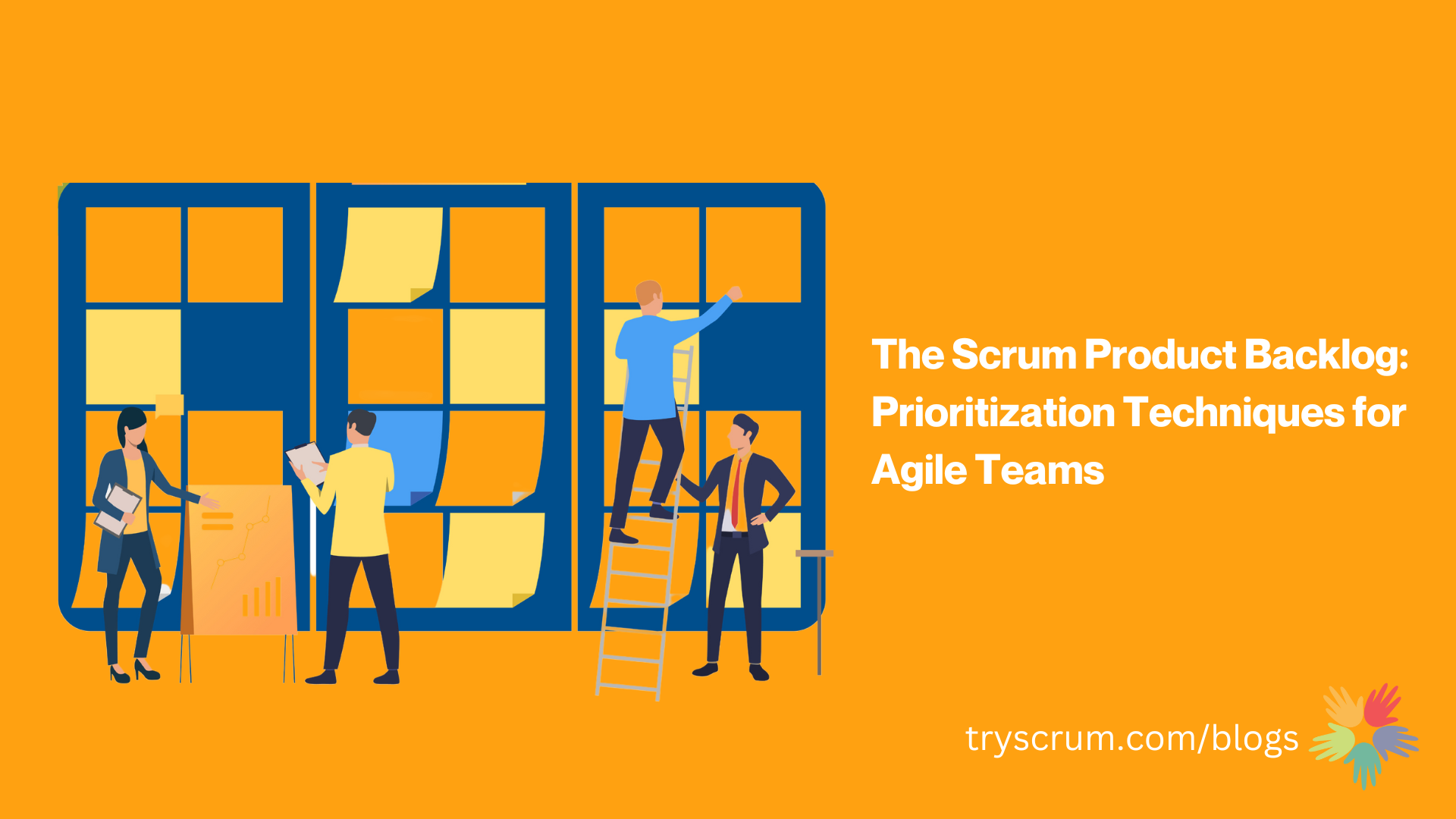
The Scrum Product Backlog: Prioritization Techniques for Agile Teams
As an agile development framework, Scrum provides teams with a flexible framework for managing complex work. At the heart of Scrum is the Product Backlog, a prioritised list of features and requirements that guides the development process. Effective prioritisation of the Product Backlog is critical for successful outcomes and requires careful consideration of a range of factors. In this post, we’ll explore some techniques for prioritising the Scrum Product Backlog that can help agile teams achieve their goals.
1. User Story Mapping
User story mapping is a technique that helps teams prioritise the Product Backlog by breaking it down into smaller, more manageable chunks. User story mapping involves visualising the product’s features and requirements, organised by user needs and business objectives. By mapping the user stories this way, teams can better understand the product and identify the essential features and requirements.
To create a user story map, teams identify the various user roles and personas that will interact with the product. Next, they generate a list of user stories describing the user’s goals, needs, and pain points. These user stories are then organised into a map visually representing the product’s features and requirements. By focusing on the user’s needs, teams can identify and prioritise the most critical features.
2. MoSCoW Prioritisation
MoSCoW prioritisation is a technique that helps teams prioritise the Product Backlog based on the importance of each feature. MoSCoW stands for Must Have, Should Have, Could Have, and Won’t Have. By categorising each feature into one of these categories, teams can prioritise their work based on the importance of each feature.
“Must Have” features are critical to the product’s success and must be included. “Should Have” features are necessary but not critical and could be left out if necessary. “Could Have” features are desirable but not essential and can be included if time and resources allow. “Won’t Have” features will not be included in the product because they are low-priority or not feasible.
MoSCoW prioritisation helps teams focus on essential features and ensures they are delivered on time and within budget. By prioritising the Must Have features first, teams can ensure that the product’s core functionality is delivered before moving on to the Should Have and Could Have features.
3. Cost of Delay
Cost of Delay is a technique that helps teams prioritise the Product Backlog based on the impact of delays. Cost of Delay measures the cost of delaying a particular feature, considering the potential revenue or value that the feature could generate. By prioritising features based on their Cost of Delay, teams can ensure they deliver the most valuable features first.
To calculate the Cost of Delay, teams consider the potential revenue or value that a particular feature could generate and the cost of delaying the feature. For example, if a specific feature has the potential to generate $100,000 in revenue per month, but delaying the feature by a month would result in a loss of $50,000 in revenue, then the Cost of Delay for that feature would be $50,000.
By prioritising features based on their Cost of Delay, teams can ensure that they deliver the most valuable features first and minimise the impact of delays on the product timeline.
4. Kano Model
The Kano Model is a technique that helps teams prioritise the Product Backlog based on customer satisfaction. The Kano Model categorises features into Must-Haves, Performance Attributes, and Delighters. Each category represents a different level of customer satisfaction. Must-Have features are those that customers expect as a minimum requirement, such as basic functionality. Performance Attributes are features that customers use to evaluate the product, such as speed or ease of use. Finally, delighters are unexpected features that exceed customer expectations, such as additional features that are not essential but add value.
By categorising features into these categories, teams can prioritise the Product Backlog based on the level of customer satisfaction they provide. For example, “Must-Have” features must be included in the product to meet customer expectations. At the same time, Performance Attributes and Delighters can be prioritised based on their potential impact on customer satisfaction.
5. Value vs Effort
Value vs Effort is a technique that helps teams prioritise the Product Backlog based on the potential value of each feature and the Effort required to deliver it. By plotting each feature on a matrix that measures value against the Effort, teams can identify the features that provide the most significant value for the least Effort.
To use this technique, teams start by identifying the potential value of each feature, taking into account factors such as revenue, customer satisfaction, and market demand. They then estimate the Effort required to deliver each feature based on complexity, resources, and delivery time. The features are then plotted on a matrix that measures value against the Effort, with the most valuable features in the top right quadrant and the least valuable features in the bottom left quadrant.
By prioritising the features in the top right quadrant, teams can focus on the features that provide the most significant value for the least Effort.
In conclusion, prioritising the Scrum Product Backlog is critical to the success of an agile development project. By using techniques such as User Story Mapping, MoSCoW Prioritization, Cost of Delay, Kano Model, and Value vs Effort, teams can effectively prioritise the features and requirements in the Product Backlog. Furthermore, by focusing on the most important features first, teams can ensure that they deliver value to their customers and stakeholders and achieve their project goals efficiently and effectively.
6. Risk vs Reward
Risk vs Reward is a technique that helps teams prioritise the Product Backlog based on each feature’s potential risk and Reward. By identifying each feature’s potential risks and rewards, teams can prioritise the features that provide the greatest Reward with the least risk.
To use this technique, teams identify the potential risks associated with each feature, such as technical complexity, dependencies, or potential impact on other features. They then estimate the potential Reward of each feature, such as increased revenue, improved customer satisfaction, or competitive advantage. The features are then plotted on a matrix that measures risk against Reward, with the least risky, most rewarding features in the top right quadrant and the riskiest, least rewarding features in the bottom left quadrant.
By prioritising the features in the top right quadrant, teams can focus on the features that provide the greatest Reward with the least risk.
7. Relative weighting
Relative Weighting is a technique that helps teams prioritise the Product Backlog based on the relative importance of each feature. By assigning weights to each feature based on preference, teams can prioritise the Product Backlog effectively.
To use this technique, teams identify the factors critical to the product’s success, such as revenue, customer satisfaction, or market share. They then assign weights to each element based on their relative importance. Finally, they give weights to each feature based on how much it contributes to each factor.
For example, a feature that increases revenue by 10% might be assigned a weight of 5 for revenue. In comparison, a feature that improves customer satisfaction by 5% might be given a weight of 3 for customer satisfaction. The features are then prioritised based on their total weighted score.
By using Relative Weighting, teams can ensure that they prioritise the features most important to the product’s success based on the factors that matter most.
In conclusion, there are many techniques that teams can use to prioritise the Scrum Product Backlog effectively. Using techniques such as User Story Mapping, MoSCoW Prioritization, Cost of Delay, Kano Model, Value vs Effort, Risk vs Reward, and Relative Weighting, teams can prioritise the features and requirements in the Product Backlog efficiently and effectively. By focusing on the most important features, teams can ensure they deliver value to their customers and stakeholders and achieve their project goals efficiently and effectively.




